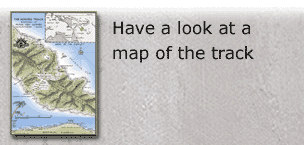MEMORIAL ROSE GARDEN
Introduction
The campaign in Papua from July 1942 to January
1943, of which the fighting on the Kokoda Track formed a large
part was, with respect to the direct security of Australia,
the most important ever fought by Australian soldiers.
After the Japanese entered the war in December
1941 they advanced rapidly towards Australia, over-running
much of south-east Asia and landing in New Britain and on
the north coast of New Guinea. In February 1942 the Japanese
high command in Tokyo postponed a decision as to whether to
invade Australia. Instead they decided to isolate Australia
from United States by seizing Port Moresby on the south coast
of the Australian territory of Papua, and by advancing through
the Solomon Islands towards Fiji. In May 1942 a Japanese attempt
to take Port Moresby by sea was thwarted by the battle of
the Coral Sea. The Japanese then decided to take Port Moresby
by two approaches. The first was by landing on the north coast
of Papua and advancing over the Owen Stanley Ranges. The second
was by landing at Milne Bay on the south-east tip of Papua.
The landing at Milne Bay on 26 August was repulsed
by Australian troops with the help of Australian fighter aircraft.
However, the Japanese thrust over the Kokoda Track, which
also began in force on 26 August, caught the Australians unprepared.
If the poorly supplied and lightly equipped Australian troops
had not slowed the Japanese advance over the mountains they
might well have reached the Port Moresby area in early September.
The consequences would have been severe for the security of
the Port Moresby airfields. If the Japanese had taken Port
Moresby their planes could have dominated the Coral Sea and
they would probably have bombed northern Queensland. Who knows,
the early decision not to invade might have been modified
to allow some troops to be landed in northern Queensland.
In any case, it would have been a major task to mount an amphibious
invasion to retake New Guinea.
Thus the fighting on the Kokoda Track was vital
to the security of Australia. But it was the nature of the
fighting and the resolution of the Australian defenders which
made it one of the heroic episodes in Australian history.
The campaign was fought in three phases. The first began on
the night of 21 July 1942 when the Japanese landed at Buna
and Gona on the north coast of Papua and advanced over the
Owen Stanley Ranges before halting at Ioribaiwa in mid September.
In the second phase the Australians conducted a counter offensive
which by 16 November had driven the Japanese from the mountains.
In the third phase Australian and American troops sought to
eliminate the Japanese pockets from the beachheads, achieving
that aim by 22 January 1943.
In the Papuan campaign, which included the fighting
on the Kokoda Track, at Milne Bay, and at Buna, Gona and Sanananda,
the total Australian and American casualties were 8,546. Casualties
from malaria exceeded 27,000; those suffering tropical diseases
numbered over 37,000. In the break up of these casualties,
the Australians lost more than 2,000 (killed); the Americans
600. During the four months of fighting in the Owen Stanley
Ranges, from 22 July to 16 November, the Australian infantry
lost 607 killed and 1,015 wounded. To illustrate the extent
of casualties, the 2/14 Battalion left Ilolo to cross the
mountains on 16 August with a strength of 24 Officers and
517 men. By the time it had been withdrawn from action at
the end of September the battalion had suffered a total of
256 casualties - 119 killed and 137 wounded. The number of
Papuan natives who died as a result of illness incurred on
the Track is unknown but was considerable.
At the time of the operations the accounts in
the newspaper referred merely to the Owen Stanley Ranges,
when describing the fighting on the jungle foot-pad that wound
its way from Ilolo in the southern foothills over the towering
mountains and then down to Kokoda in the northern foothills.
The path came to be known as the Kokoda Track or Kokoda Trail.
A Memorial Walkway has been constructed at Rhodes
Park, Concord to commemorate all veterans who served in World
War II. The Memorial Walkway has been named the Kokoda Track
Memorial Walkway in recognition of the young Australians who
served on the Track; those young men who fought, died and
suffered to keep Australia safe from invasion. The efforts
of the native Papuans - the legendary "fuzzy wuzzy angels"
are also acknowledged. Cold, hungry and often over burdened,
they carried forward the supplies and facilitated the evacuation
of the casualties with devotion and humanity. It is hoped
that those who tread the path of this Memorial Walkway gain
a greater appreciation of the important events that took place
in Papua in 1942.
|











